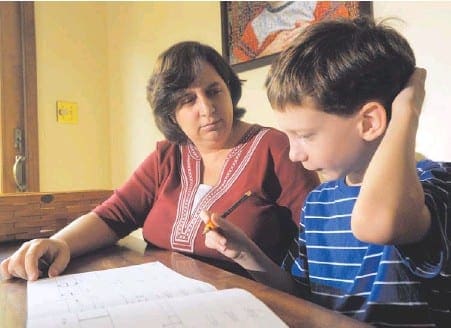A blood test could have revealed the disorder far earlier
The Washington Post,
Years wreaking havoc on families who struggle to figure out what is wrong.

Jen Driscoll works with her son, Adam, as he practices his writing skills. Tests have shown his intelligence to be above average.
Looking for answers
Adam was born four weeks early, and doctors told Driscoll and her husband, Toby, a math professor, that was the reason he had trouble feeding as a newborn. He seemed unable to suck but then learned to do it, his mother recalled, noting a recurring pattern. “From early on, it seemed like we had to teach him,” Driscoll said, recalling how she taught him to pick up blocks and use a shape-sorting toy, grasping his hand and guiding it. His limbs seemed somewhat floppy, but doctors ruled out cerebral palsy.
His experienced pediatrician dismissed Driscoll’s increasingly urgent questions about Adam’s development. “It’s not like he won’t be walking and talking when he goes to college,” she recalled the doctor telling her.
But by 15 months, the age at which her older son walked, Adam showed no sign of taking steps. He wasn’t talking or even babbling. The staffers at his daycare center were also concerned, and the pediatrician referred him to an early intervention program.
A nurse came to the Driscolls’ home to observe Adam. To his parents’ dismay, she pronounced Adam developmentally on track and said he was “just about ready to walk”; in fact, he did not take his first steps for eight more months when he was nearly 2.
Social problems were also emerging. In daycare, Adam “hated to have other kids approach him. He wanted to be alone,” his mother said. And he seemed terrified by swings or the slide. When he was nearly 21⁄ his
2 families attended a Christmas party at the home of a developmental pediatrician with whom Driscoll worked. The doctor later told Driscoll that Adam’s behavior struck her: First, he hid behind the sofa and had to be coaxed out. Then he sat all night quietly beside his parents, never running around and playing like the other children.
At Driscoll’s request, the developmental pediatrician evaluated Adam, ruling out autism. He was diagnosed with an unspecified motor and speech delay and enrolled in a special-ed day-care center.
There he made significant gains, but Driscoll had become convinced something more global was wrong by then. “I felt that everything going on had to be tied together,” she said. “There were too many problems in too many domains.” Specialists working with Adam and his regular pediatrician counseled patience.
But a physical therapist agreed with Driscoll and urged her to see S. Charles Bean, a pediatric neurologist at the Nemours/Alfred I. DuPont Hospital for Children in Wilmington, where Driscoll was employed. “If anybody can figure it out, it’s Chuck Bean,’” the physical therapist told Driscoll.
During an intensive, 90-minute evaluation in November 2007, Bean took a detailed history, watched Adam walk and eat, and played games with him. Then he ordered blood tests for several metabolic and genetic disorders. He told Driscoll he suspected Adam had fragile X syndrome, the most common cause of inherited mental impairment, responsible for a range of problems, from learning disabilities to mental retardation.
Driscoll thought fragile X was less likely than a mild form of muscular dystrophy.
Two weeks later, the results came back from the lab. “You’re not going to believe this one,” she recalled Bean telling her. They were both wrong.
‘A punch in the gut.’
Adam had Klinefelter syndrome, also known as XXY syndrome. The disorder, which is not hereditary, occurs very early in fetal development when boys randomly acquire an extra X sex chromosome rather than one X and one Y. Named for Harry Klinefelter, the physician who first described it in 1942, the syndrome affects one in 500 to 1,000 males, according to the Genetics Home Reference. In addition to being one of the most common chromosomal disorders, it is also one of the most stigmatized; early studies were conducted among prison inmates. Researchers erroneously linked the disorder with criminal behavior and low IQ, a legacy that has been hard to shake.
“Early on, it got a terrible press,” said Samango-Sprouse, a neurodevelopmental specialist who works with children who have sex chromosome disorders. That linkage, she suspects, prevents some doctors from considering it as a possible diagnosis in children.
XXY syndrome varies in severity, although it almost always causes infertility because it impairs testosterone production. Males who do not have the extra X chromosome on all their cells may have mild cases and never know they have the problem until discovered during an infertility workup. Boys who are more severely affected may struggle with physical, social, and language development. As babies, they tend to be shy and undemanding.
If the disorder is diagnosed early, boys can be treated with supplemental testosterone during puberty, which can boost the male sex hormone levels during a critical growth phase, fueling the development of bigger muscles and more facial and body hair, which tends to be sparse. As teenagers, they may experience breast development; most are tall.
Bean said that the diagnosis could be difficult to make before puberty because Klinefelter mimics other problems. “It’s not something I frequently see,” as a neurologist, he said, unless a child has significant motor problems.

Jen and Toby Driscoll play with Adam. “We feel tremendously lucky that we’ve gotten him diagnosed this young,” she said.
Driscoll said her initial reaction after Adam’s diagnosis was to breathe “a huge sigh of relief. It explained everything, and it’s not going to kill him. I realized the path was pretty clear” about what needed to be done.
“But,” she added, “it was a bit of a punch in the gut, too,” because the diagnosis will affect Adam for the rest of his life. Driscoll said her family also grapples with the stigma that accompanies a genetic disorder, “especially one involving sex chromosomes,” and with misinformation. When people learn that Adam possesses two X chromosomes, they often ask his mother if he is gay. (Studies have found that Klinefelter’s patients are no more likely to be gay than the general population.)
Heart defects often accompany XXY syndrome, but a cardiologist found no such problems in Adam. He is continuing to receive physical therapy, and testing showed his intelligence is above average.
The Driscolls have told Adam about his diagnosis, explaining that he has an extra chromosome, “like an instruction book that was printed twice.” She doesn’t want Adam to think the problems are his fault, as did some men she has met whose disorder was not diagnosed until adulthood but had been told as children that they were lazy, dumb, or mentally ill.
Adam, she says, is persistent and determined to surmount his difficulties. A few weeks ago, the little boy who hated playing with other children invited 10 classmates to his first-ever party to celebrate his seventh birthday.
Had Adam’s condition been diagnosed earlier, Driscoll believes her family would have been spared years of unnecessary anxiety and frustration. “We feel tremendously lucky that we’ve gotten him diagnosed this young,” she said. “But I worry about the other kids,” whose baffling problems could be explained by a blood test.
Written by Sandra Boodman
Photos By Doug Kapustin for The Washington Post




Leave A Comment